Posted by: Dorothea Preis in News
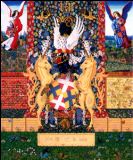 We may be 550 years late for the Battle of Northampton, fought on 10 July 1460 between the Yorkist forces commanded by the Earl of Warwick and Henry VI’s Lancastrian forces, but this coming weekend there will be lots of action for latecomers like us (and more peaceful, too). A wide variety of Battle related activities will take place at at the original battle site at Delapré Abbey, including a re-enactment of part of the Battle. Other attractions are: Jousting on horseback with full armour, gunpowder and large canon demonstrations, the display of a soldiers’ encampment and music from the period of the Battle. And if all this makes you hungry and thirsty there will also be food stalls offering medieval fare.
We may be 550 years late for the Battle of Northampton, fought on 10 July 1460 between the Yorkist forces commanded by the Earl of Warwick and Henry VI’s Lancastrian forces, but this coming weekend there will be lots of action for latecomers like us (and more peaceful, too). A wide variety of Battle related activities will take place at at the original battle site at Delapré Abbey, including a re-enactment of part of the Battle. Other attractions are: Jousting on horseback with full armour, gunpowder and large canon demonstrations, the display of a soldiers’ encampment and music from the period of the Battle. And if all this makes you hungry and thirsty there will also be food stalls offering medieval fare.
This fun weekend will be followed by a conference on the Battle of Northampton on the anniversary itself (10 July) at the Northampton Museum and Art Gallery, organised by The Battlefields Trust. The programme promises to be fascinating with talks on “The Wars of the Roses and the Northampton Campaign”, “Developments in Warfare During the 15th Century”, “The Battle of Northampton”, “Where Is the Battlefield?” and “Finding Medieval Battlefields”.
You can find more information on the weekend at Delapré Abbey here and about the conference at Northampton Museum here.
Illustration: War of the Roses © Andrew Jamieson, www.medieval-arts.co.uk
Tags: Battles, Nevilles, Wars of the Roses
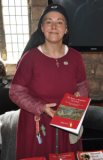 Helen Cox, author of The Battle of Wakefield Revisited, let us know that her book has been launched successfully. Approx. 30 people attended the official moment, among them Peter Hammond, the Chairman of the Richard III Society; Sue Galloway, the Lord Mayor of York; Richard Watson, the Sheriff of York; Terry Suthers, the Chairman of the York Archaeological Trust and Mark Taylor, the Chairman of the Towton Battlefield Society as well as some more friends from the Towton Battlefield Society.
Helen Cox, author of The Battle of Wakefield Revisited, let us know that her book has been launched successfully. Approx. 30 people attended the official moment, among them Peter Hammond, the Chairman of the Richard III Society; Sue Galloway, the Lord Mayor of York; Richard Watson, the Sheriff of York; Terry Suthers, the Chairman of the York Archaeological Trust and Mark Taylor, the Chairman of the Towton Battlefield Society as well as some more friends from the Towton Battlefield Society.
Obviously this was a very exciting occasion for Helen, as this is her first book that she has written on her own and the result of years of research. Helen says that she is especially happy that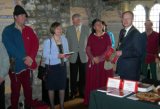 it means she can “take a public stand in support of Richard, Duke of York, who usually gets such a rough ride from historians”. The site for this rehabilitation was particularly appropriate as this was where the Battle of Wakefield effectively ended with the heads of Richard of York and his son Edmund and the Earl of Salisbury displayed on the York city walls after the battle.
it means she can “take a public stand in support of Richard, Duke of York, who usually gets such a rough ride from historians”. The site for this rehabilitation was particularly appropriate as this was where the Battle of Wakefield effectively ended with the heads of Richard of York and his son Edmund and the Earl of Salisbury displayed on the York city walls after the battle.
For the launch Helen came kitted out with the full re-enactors necessities like a basket of crocks and 15th century goodies, swords, helmets, padded jacks, bows and arrows and sundry bits of costume as well as obviously cartons of books.
 To find out more about the book have a look at the flyer Helen provided to us (here). You can order the book from YPD Books. I ordered it yesterday for £12.00 + £9.95 for shipping to Australia, which altogether came to approx. Aus$ 40.00. And don’t forget to visit Helen’s website as well.
To find out more about the book have a look at the flyer Helen provided to us (here). You can order the book from YPD Books. I ordered it yesterday for £12.00 + £9.95 for shipping to Australia, which altogether came to approx. Aus$ 40.00. And don’t forget to visit Helen’s website as well.
We would also like to thank Helen for providing the photographs of this exciting occasion to us.
Tags: Battles, Books, Richard Duke of York, Wakefield, Wars of the Roses

St Albans – Hertfordshire
When considering which could be my next Ricardian Place in Hertfordshire, the recent 555th anniversary of the First Battle of St Albans (22 May 1455) offered the obvious answer. During our life in England St Albans was a popular haunt for us, for shopping, eating out or just soaking up the atmosphere. I also happened to have a number of private students there – hello to Tony and Jacky, should you read this.
There have been settlements in the St Albans area for a long time. The first that we know of was by the Celtic Catuvellauni tribe, who called it ‘Verlamion’. During the Roman period it became ‘Verulanium’, the second largest town in England after Londinium, situated on Watling Street heading north.[1] Most of the remains of the Roman town are today covered by Verulanium Park, but some parts have been excavated and can be visited. For instance the Hypocaust (including an in situ mosaic); the Roman Theatre of Verulamium; and the remains of the Roman city walls and London gate.[2] Read the rest of this entry »
Tags: Battles, Church, Hertfordshire, St Albans, Wars of the Roses, Yorkists
Posted by: Dorothea Preis in News
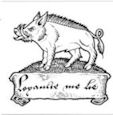 When earlier this year archaeologists made the discovery of the true location of the Battle of Bosworth public, they showed various artefacts that led to the discovery. One of them, and for me the most fascinating and poignant one, was a small silver boar badge. The White Boar was Richard’s emblem and badges like this would have been worn by his knights. They were primarily awarded at ceremonies like Richard’s coronation or the investiture of his son as Prince of Wales. It is believed that this one was lost from the tunic of one his knights as he fought alongside his rightful king against the usurper Henry Tudor. Read the rest of this entry »
When earlier this year archaeologists made the discovery of the true location of the Battle of Bosworth public, they showed various artefacts that led to the discovery. One of them, and for me the most fascinating and poignant one, was a small silver boar badge. The White Boar was Richard’s emblem and badges like this would have been worn by his knights. They were primarily awarded at ceremonies like Richard’s coronation or the investiture of his son as Prince of Wales. It is believed that this one was lost from the tunic of one his knights as he fought alongside his rightful king against the usurper Henry Tudor. Read the rest of this entry »
Tags: Battles, Contemporaries, Richard III
Posted by: Dorothea Preis in News
From our friends at Barley Hall in York (more info here), or to be precise from the April 2010 issue of Quid Novi? A newsletter for the friends and supporters of Barley Hall, we learned that the York Archaeological Trust has agreed to take over the Museum at Micklegate Bar and make it one of their attractions. This means that the Bar joins Barley Hall as the second mediaeval attraction in their portfolio.
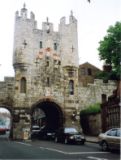
Micklegate Bar in York (author’s own photograph)
Micklegate Bar is York’s most important gateway and has served a number of important roles since its construction in the 12th century, including being the main point of entry through which a reigning monarch enters the city.
The new museum will open later in May and an interesting programme of events has been planned. To celebrate the launch of the new exhibition, the Wars of the Roses will be brought to life in York once more with various Bank holiday events and talks to tie into.
The programme kicks off on 29 May at Barley Hall with the drama of The Queen’s Tale: Margaret of Anjou. The following day there is a coach tour to Sandal Castle. 31 May sees Helen Cox launching her book The Battle of Wakefield Revisited at Micklegate Bar and at the Mansion House there is a series of talks on Great Battles of the Wars of the Roses.
Later in the (Northern hemisphere) summer there will be a series of guided tours to various battle sites in the area. For Ricardians the most interesting would surely be the one to Sheriff Hutton on 15 June, and a day at Pontefract Castle and the Wakefield battle site under the heading Dukes, Earls and Nursery Rhymes: Yorkshire at War in the 15th Century, which is led by Helen Cox, on 1 August. For more information on all these fascinating events check out the website of Barley hall as well as that of the Jorvik Viking Centre (here).
Tags: Battles, Books, Sandal, Yorkshire
Posted by: Dorothea Preis in News
 Helen Cox, the author of the forthcoming new evaluation of the Battle of Wakefield (see here), let us know that a half-hour programme on the Battle of Towton has just been broadcast on BBC 1, as part of a series called ‘A History of the World’. Helen and a number of other Towton Battlefield Society/Frei Compagnie re-enactors feature in this programme.
Helen Cox, the author of the forthcoming new evaluation of the Battle of Wakefield (see here), let us know that a half-hour programme on the Battle of Towton has just been broadcast on BBC 1, as part of a series called ‘A History of the World’. Helen and a number of other Towton Battlefield Society/Frei Compagnie re-enactors feature in this programme.
She also informed us that the programme would be available on the BBC iPlayer (here). We were so thrilled to think that now we would also be able to watch programmes like this, but alas the BBC iPlayer for TV is available to the UK only. Why this discrimination?
Tomorrow, 20 May, BBC2 will broadcast in its ‘History Cold Case’ series a programme on the skeleton of a man found at Stirling Castle who died after a jolly joust. That would also be interesting, if only we could watch it!
Tags: Battles, Media
 We first heard on the Ricardian grapevine about a new analysis the Battle of Wakefield and a fresh perspective on Richard of York’s final battle on 30 December 1460. The book by Helen Cox is due to be published later this month.
We first heard on the Ricardian grapevine about a new analysis the Battle of Wakefield and a fresh perspective on Richard of York’s final battle on 30 December 1460. The book by Helen Cox is due to be published later this month.
On her website Helen tells us that historians have for a long time tried to reason why the Duke of York would have taken on the much stronger Lancastrian forces in this battle. Some believe that the Duke was reckless and stupid, an ageing commander past his prime who made a bad decision – or that he charged out in blind fury because the enemy had sent heralds to insult him. Others think he made a heroic but futile attempt to rescue some of his foragers who were under attack; or that he didn’t realise how big the Lancastrian army was, because many of their troops were cunningly hidden in nearby woodland, waiting to charge out and ambush him.
Helen says that she has never been convinced by these theories, which aren’t well supported by contemporary reports of the battle. So in The Battle of Wakefield Revisited she has tried to pull together and re-examine all the surviving historical and archaeological evidence relating to the encounter. She promises us a far simpler and more plausible explanation of why the Duke of York rode out to face his enemies that day.
The book will be launched on 31 May 2010 at Mickelgate Bar in York. Helen and her husband Mick will be there in costume to sell and sign copies. What a pity that we won’t be able to join them!
So we contacted Helen, to find out how we would be able to get hold of copies of this fascinating new study. She informed us that the book will be available online from York Publishing Services £12.00 sterling plus p+p (at today’s exchange rate approx. Aus $20 plus p+p).
She also told us that writing the book was a real labour of love for the past 18 months. She is fortunate enough to live only a mile from the Duke of York’s castle at Sandal, so she regularly visits it and often thinks of him and her favourite of his sons. And I’m sure you can all guess who that is!
Keep an eye on Helen’s website for further information and developments.
Tags: Battles, Books, House of York, Richard Duke of York, Richard III
 The March issue of the BBC History Magazine has finally arrived on Australian shelves. As I had heard that it contains extensive coverage of the new location of the Battle of Bosworth it was impatiently awaited. So when I popped into my local newsagent the other day, the first thing that caught my eye was the picture of our man – Richard III – on the cover of the magazine.
The March issue of the BBC History Magazine has finally arrived on Australian shelves. As I had heard that it contains extensive coverage of the new location of the Battle of Bosworth it was impatiently awaited. So when I popped into my local newsagent the other day, the first thing that caught my eye was the picture of our man – Richard III – on the cover of the magazine.
The magazine shows the most important finds like the silver gilt boar badge, which might show the area where Richard fell, as well as others. There is also a discussion about the use of guns in the battle and a description of how the actual location was found (with maps).
Other articles which caught my eye in the magazine is an evaluation by Leanda de Lisle (The Sisters Who Would Be Queen) of Jane Grey, where the author argues that it was her firm religious stance that sealed her fate. Linda Porter examines the relationship between Henry VIII and his last wife, Katherine Parr. And there are several articles covering the 16ooth anniversary of the end of Roman Britain in 410 AD.
This issue is certainly well worth buying and keeping.
Tags: Battles, Henry Tudor, Richard III
Posted by: Dorothea Preis in News
 The recent discovery of the actual site of the Battle of Bosworth made headlines around the world. It now seems that we might also have to rethink the location of the Battle of Barnet.
The recent discovery of the actual site of the Battle of Bosworth made headlines around the world. It now seems that we might also have to rethink the location of the Battle of Barnet.
The Battle of Barnet was fought on Easter Sunday, 14 April 1471, between Edward IV, who had returned from exile in Burgundy, and the Yorkists on the one side, and the Earl of Warwick and the Lancastrians on the other. This was the first battle in which the then 18 year-old Richard, Duke of Gloucester, fought and some think that he commanded the vanguard. Visibility was greatly reduced due to a thick mist. This mist seems to have lasted until the present, because the exact location of the site is still being disputed. The reason is that so far no archaeological evidence has been found, possibly because researchers were looking at the wrong spot and had concentrated on the registered site in Hadley Green. Read the rest of this entry »
Tags: Barnet, Battles, Edward IV, Richard III, Wars of the Roses
 Helen Cox, author of The Battle of Wakefield Revisited, let us know that her book has been launched successfully. Approx. 30 people attended the official moment, among them Peter Hammond, the Chairman of the Richard III Society; Sue Galloway, the Lord Mayor of York; Richard Watson, the Sheriff of York; Terry Suthers, the Chairman of the York Archaeological Trust and Mark Taylor, the Chairman of the Towton Battlefield Society as well as some more friends from the Towton Battlefield Society.
Helen Cox, author of The Battle of Wakefield Revisited, let us know that her book has been launched successfully. Approx. 30 people attended the official moment, among them Peter Hammond, the Chairman of the Richard III Society; Sue Galloway, the Lord Mayor of York; Richard Watson, the Sheriff of York; Terry Suthers, the Chairman of the York Archaeological Trust and Mark Taylor, the Chairman of the Towton Battlefield Society as well as some more friends from the Towton Battlefield Society. it means she can “take a public stand in support of Richard, Duke of York, who usually gets such a rough ride from historians”. The site for this rehabilitation was particularly appropriate as this was where the Battle of Wakefield effectively ended with the heads of Richard of York and his son Edmund and the Earl of Salisbury displayed on the York city walls after the battle.
it means she can “take a public stand in support of Richard, Duke of York, who usually gets such a rough ride from historians”. The site for this rehabilitation was particularly appropriate as this was where the Battle of Wakefield effectively ended with the heads of Richard of York and his son Edmund and the Earl of Salisbury displayed on the York city walls after the battle. To find out more about the book have a look at the flyer Helen provided to us (here). You can order the book from YPD Books. I ordered it yesterday for £12.00 + £9.95 for shipping to Australia, which altogether came to approx. Aus$ 40.00. And don’t forget to visit Helen’s website as well.
To find out more about the book have a look at the flyer Helen provided to us (here). You can order the book from YPD Books. I ordered it yesterday for £12.00 + £9.95 for shipping to Australia, which altogether came to approx. Aus$ 40.00. And don’t forget to visit Helen’s website as well.







